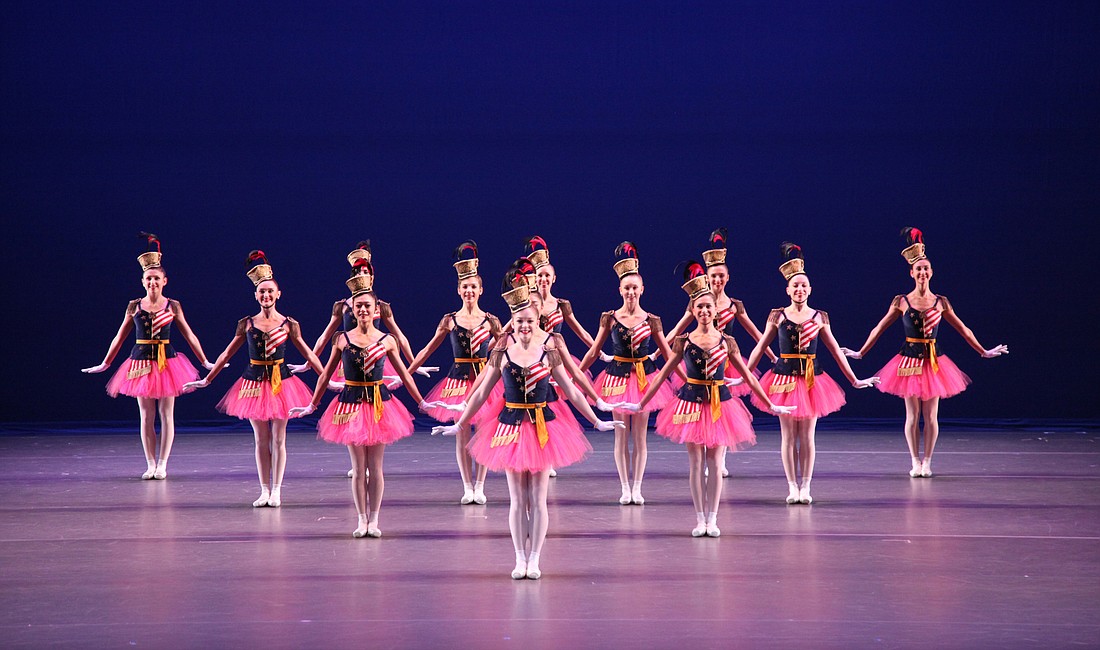- April 26, 2024
-
-
Loading

Loading

The Sarasota Ballet’s “Poetry and Liberty” program, performed last weekend at the Van Wezel Performing Arts Hall, brought together two great choreographers in two very different ballets. The company premiere of Sir Frederick Ashton’s “Apparitions” was full of dark drama and tragedy, while George Balanchine’s “Stars and Stripes” was lively and upbeat.
Not performed in nearly 50 years, Director Iain Webb has influenced ballet history by having the Sarasota Ballet perform Ashton’s “Apparitions.” Even though it might not be an audience favorite, the revival of “Apparitions” is a big deal to the ballet world, which premiered in 1936 and was last performed in 1970 by The Vic-Wells Ballet in London. “Apparitions” was also one of the first ballets that Ashton choreographed featuring Margot Fonteyn, which sparked her influence as Ashton’s muse in many of his subsequent works. This year marks the 100th anniversary of Fonteyn’s birth, making the revival of “Apparitions” even more poignant.
The story of a poet gone mad seeking true love is carried by Marcelo Gomes, who dances the role of The Poet. Gomes’ impeccable technique is one to be marveled at. Every position and every step is precise as if this incredible star still needs to think about every fifth position, every turn and every pointe of the toe.
The beautiful score by Franz Liszt is as magical as the scenery, originally designed by Cecil Beaton. One could only imagine how it took breaths away in 1936. During the scene in The Ballroom, those breaths were taken away once again by the flowing gowns and tutus worn by the female dancers during the many waltzes and gallops.
In The Snow-Clad Plain women in black and white tutus and classic Ashton-style dramatic multi-pointed headpieces nodded their heads and bended their arms and bodies emulating the movement of a bell ringing exasperating the sounds in the crazy poet’s head.
As the Woman in the Ball Dress, the poet’s attempt at love, Victoria Hulland was graceful and strong at the same time. Although her sumptuous gown seemed to overpower her at times consuming her and making the momentum needed for certain pirouettes difficult.
Reviving “Apparitions” was special for Sarasota Ballet, giving its dancers a chance to recreate Ashton’s characters with their own spin.
Although not born in America, it is said that Balanchine had much love and respect for his adopted country. He celebrated his patriotism with the 1958 ballet “Stars and Stripes.” The Sarasota Orchestra, led by guest conductor Ormsby Wilkins, flawlessly performed the John Philip Sousa score. The work is a delight for the audience and dancers alike.
The exuberant cast committed to the Balanchine style from start to finish. A corps of women kicked, and soloists twirled batons. Elizabeth Sykes marveled the audience while she did a series of développé à la seconde while doing an impressive baton twirling sequence in the First Regiment — “Corcoran Cadets.”
The third regiment was particularly impressive as an army of men leapt and spun in unison. Ivan Duarte ruled in “Thunder and Gladiator” doing a multitude of impressive split jumps. He also marveled while doing a series of à la seconde turns while the corps of men costumed in shiny uniforms did a jeté manages around him. Although audiences surely miss Logan Learned, Duarte’s performance was technically flawless and enthusiastic.
The standout was the fourth campaign featuring a pas de deux between Kate Honea as Liberty Bell and Ricardo Rhodes as El Capitan. Honea always dances with marvelous musicality and it shines most in Balanchine ballets. Paired with Rhodes’s virtuosity, the two of them exuded confidence and grace. The piece ended with a giant American flag upstage, energetic dancers who wore genuine smiles and an audience on their feet.
To describe this show in short — we were all having fun.